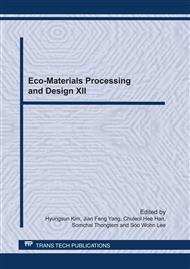p.109
p.113
p.117
p.121
p.129
p.133
p.137
p.141
p.145
Photocatalytic Activities of Transition Metal-Doped TiO2 Nano-Powders by Sonochemical Method and their Physicochemical Properties
Abstract:
With respect to metal doping into TiO2, the doping limits for V, Cr, Zr, Nb, Mo, and W are predicted to be higher than other transition metals according to the binding energy calculations in a unit cell model of anatase TiO2, which suggests that Cr and W can be doped into anatase structure more easily than Ag or Pt, for example. Our investigation has twofold research objectives. One is to prepare metal-doped TiO2 nano-powders from these transition metals, and the other is to test photocatalytic activity of each resulting powder. For the former, sonochemical process has been used to produce Cr-doped, W-doped, Ag-doped, and Pt-doped TiO2 nanoparticles. For the latter, we have performed photocatalytic oxidation of methylene blue. The combined results of the morphology and photocatalytic activites have enabled characterization of the physicochemical properties of these transition metal-doped nanoparticles.
Info:
Periodical:
Pages:
129-132
Citation:
Online since:
July 2011
Authors:
Keywords:
Price:
Сopyright:
© 2011 Trans Tech Publications Ltd. All Rights Reserved
Share:
Citation:


